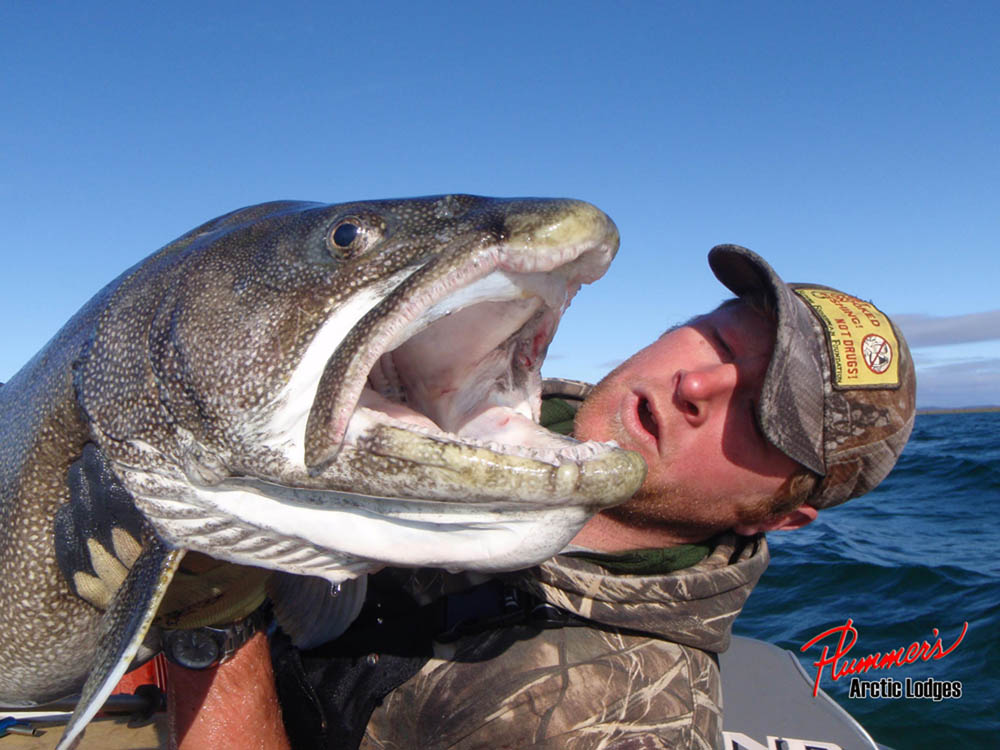Plummer's Blog

When is the best time to catch trophy lake trout on Great Bear Lake?

A guide’s perspective on one of the most frequently asked questions at Plummer’s
By Craig Blackie
Anyone who knows anything about trophy lake trout knows that Great Bear Lake produces the largest trout in the world. So it’s no surprise that anglers want to know when they have the highest odds of catching that fish of a lifetime. Unfortunately, there’s no easy answer to this question. The truth is that big trout are caught throughout our short season. Serious trophy hunters have their favourite times and interestingly, they are spread throughout the season. For example, a lot of people prefer to come up for the first week when the hogs are in the shallows. Others such as the unofficial world record holder, Aivar Slucis (spelling?), prefer the mid-season period. Lastly Lloyd Bull, the current world record holder, comes up every year during the late season period. With big fish being caught throughout the season, picking a week may seem daunting. To hopefully shed some light on this, I have scoured my fishing journal that has been compiled over the last eleven seasons, and broken down the various parts of the fishing season in terms of big fish potential.
Mid July:
Many people book their trip to Great Bear Lake during the first few weeks of the season. The reason is simple: Giant fish are caught during this time. This is when many of the fabled days of catching numbers of giant fish occur. Indeed, my best day and a half of guiding happened during this period. The late (and great) Pat Alexander and I guided the Hystad family to 40 trophies including 2 over 50 pounds and 8 over 40 pounds. Moreover, several of the biggest lakers ever caught on rod and reel were caught during this period. These include the old 66 pound world record, an unofficial record of 74 pounds and a 70 pound giant caught by eleven year old Dixon Cleere. With success like this, it’s easy to see why early season is a popular choice for trophy hunters.
Before changing your bookings to the first week, it’s worth considering all the factors. Much of the best early season fishing takes place at flyouts such as Shipwreck (AKA the Pig Pen), the Inlet, Hornby Bay, and MacIntosh Bay. Since these areas are characterized as shallow sandy bays it often doesn’t take long for the big fish to move out. What typically happens is the first few groups into a typical spot will have exceptional days and this in turn gets others wanting to fish there. Based on this feast or famine scenario, a small number of anglers will catch the majority of the big fish. By breaking off from the herd and fishing other areas by boat, you maximize your chances of getting some virgin water to yourself. Your guide will know of several such spots.
Another thing that people need to be aware of during early season is ice. The ice typically goes out around late June or early July but a period of time without wind will cause the ice to hang around a bit longer. This can make travelling on the lake somewhat challenging or downright impossible in early July. This focuses the majority of the fishing pressure on smaller areas such as close to the lodges and at flyouts. It can get a bit discouraging at times but experienced anglers and guides alike are not deterred by this because they know if they can be first to a spot, it often means big fish. Put another way, when most guides fly over a partially frozen lake at the start of the season, their reaction is not “Oh no, ice”. The reaction usually involves “high fives” and cheering! Go figure.
Late July:
The middle of the season is a great time of year to be on Great Bear. The ice is long gone and the weather is usually warm and stable. Other types of fishing become popular at this time of year. It is possible to catch trophy grayling, pike, and lots of small to medium sized lakers during a trip that also involves chasing the giants. For the strict trophy hunters, they have a field day at this time because literally dozens of big fish spots become productive. As opposed to being confined to small areas in back bays, the fish are more spread out. This makes the game that much more rewarding. Instead of only fishing a handful of spots in a day, an angler can fish more than a dozen areas- something that definitely keeps it interesting. Moreover, the fish have had some quality feeding time since ice out which means a given fish can be heavier at this time of year.
What normally happens during this period is that trout of all sizes move out to offshore reefs and exposed points. The big fish will usually hold off the deeper edges and move shallow to feed when they’re hungry and conditions permit. Favourable conditions for fishing the shallower edges of this structure include a good onshore wind. Presumably the bigger fish have the advantage of greater stealth in rough water. On these choppy days, the action can be fast and furious. My best day of guiding during the 2008 season took place at this time of year. With a good 4-5 foot chop rolling in on an offshore island, the Wallace group managed to catch 3 over 40lbs and several other trophies over twenty pounds.
On the other hand, if the weather is sunny and calm, try fishing off the deeper edges. The big fish will be there. They may just need a little convincing. It is this point that ultimately separates the early from the mid/late season periods. During the early season, the fish are usually either in the shallows (and hence relatively easy to catch) or they’re not. If they’re not, both anglers and guides can be left scratching their heads. The thing that separates the rest of the season is that the fish can be caught under most conditions. You just need patience. If you don’t mind trolling for hours on end, it will pay off sooner or later. If you don’t believe me, talk to anyone who regularly fishes Trophy Lodge mid season and ask them about how productive this approach is on areas such as the “x shoal”. If you need further convincing, ask Aivar Slucis about his enormous fish over 78 pounds that he caught on a flat sunny day in early August. Just for the record, that’s the largest angler caught lake trout….ever!
Early August:
The last few weeks of August can produce some of the biggest fish of the year. The reason for this is that they congregate in preparation for spawning. As such, it’s worth mentioning something about where and when lakers spawn. It just so happens that this is something that I have been extensively studying over the last four years.
Lake trout are fall spawners, which translates to late August/ early September on Great Bear. Lakers spawn on offshore reefs that are exposed to the wind and waves. As many of you know, there are different types of trout in Great Bear with the smaller “redfins” and larger “greys” being the predominant forms. Genetic data shows that the two types segregate themselves at spawning time and that particular reefs produce the same type of trout every year. What this means for anglers is that if you target areas adjacent to known “grey” spawning sites, the odds of catching a giant are increased. By the middle of August, the big fish will be in the vicinity of the spawning areas so it’s just a matter of putting your time in to catch them.
Tremendous fish are caught by those anglers that have picked up on the spawning shoal idea. For example, Lloyd Bull fishes these areas exclusively and his extensive scrap book of trophies is incredible. Moreover, he holds the current world record of 72 pounds. Through the course of my research on these spawning sites, I am almost embarrassed about how many giants I’ve caught from these areas.
Now I suppose you’re wondering where these spots are. OK fine, I’ll tell you. Listed below are the areas that I’ve been looking at and these are only the “grey” spawning shoals that we know about. At Neiland Bay, several productive shoals can be found and these include Phillips Reef, Bull Shoal and Stockyards. At Trophy Lodge, lots of big fish spawn around No Beans Island and there are certainly other areas that we don’t know about. Lastly, the Main Lodge has several productive areas around Caribou Point and Bloody River. As for specifics, ask your guide. He will know the specific shoals that are producing.
One thing to keep in mind at this time of year is that this is the onset of autumn. This can make for cooler weather and choppy seas. It’s a trade-off though since the best fishing often occurs in rough conditions. That being said, the weather can be beautiful at this time of year. One definite benefit during this period is that one has the opportunity to see the northern lights, an iconic experience of the arctic. It’s just up to the angler to stay awake past 11pm, something that many well-worked guests have a hard time doing!
Late August:
In summary, this breakdown highlights the big fish potential at different times of the season as well as some of the other pros and cons of each period. Moreover, I hope it has become clear that it is difficult to determine which time is best. The photos included in this article don’t help either. The biggest fish my guests caught in 2008 were spread throughout the season. I suppose another way of looking at the question of timing is that you are hard pressed to pick a bad week!
One thing that anglers definitely have to keep in mind is there are no guarantees: This is fishing after all! A useful calculation to consider is the number of hours needed to catch a 50 pounder. It turns out that a 50 pounder (or better) is caught at anywhere between 1000 and 1500 hours of fishing time (depending on which year you looking at) which is obviously much greater than the 50 to 80 hours put in by most guests in a week. Be realistic- chances are you won’t catch a 50. Nevertheless, a trip to Plummer’s on Great Bear Lake gives you the highest odds in the world of catching that true giant. Just make sure that when you get that hit, set the hook and keep a tight line. It could very well be that fish of a lifetime! Lastly, big fish are by no means the only attraction at Plummer’s. Sure it’s nice to catch a trophy lake trout but it is only part of a true arctic experience.

More News


